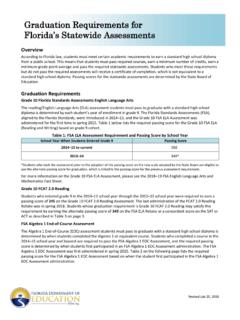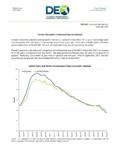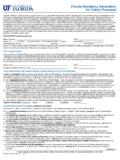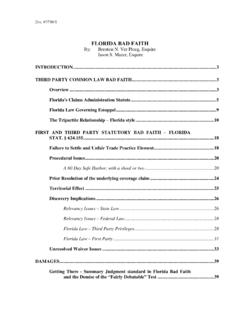Transcription of Florida’s Motor Vehicle No-Fault Law
1 November 2005 Prepared for The florida Senate Prepared by Committee on Banking and Insurance florida s Motor Vehicle No-Fault Law Report Number 2006-102 Table of Contents Background ..5 Overview of florida s No-Fault Law; Report Objectives ..5 Development of the No-Fault Concept ..6 Legislative History of florida s No-Fault Law ..7 Automobile Reparations Reform Act of 1971 ..7 Subsequent Legislative Changes ..10 2000 Grand Jury Report and No-Fault Reforms of 2001 and The Constitutionality of the No-Fault Current Automobile Insurance Provisions ..20 Mandatory Personal Injury Protection (PIP) ..21 Property Damage Liability (PD) ..22 Optional Coverages ..23 Bodily Injury Liability Coverage (BI)..23 Uninsured Motorist Coverage (UM)..23 Other Optional Financial Responsibility Findings.
2 26 Is florida s No-Fault System Working?..26 Availability of Motor Vehicle Compliance with Mandatory Vehicle Insurance Laws ..29 Efforts to Combat Motor Vehicle Insurance Fraud and Unreasonable Denial of Claims by Affordability of Motor Vehicle Profitability of Auto Insurance Companies ..49 Adequacy of Motor Vehicle Coverage ..52 PIP Loss Costs in florida and Nationwide ..52 Bodily Injury (BI) Liability Loss Costs in florida and BI Liability Claims BI Liability Claims Severity ..60 BI Liability Claims Costs (Pure Premium) ..61 Medical Costs in florida ; Fee Schedules and Treatment Protocols ..62 Attorney Involvement in PIP and BI Auto Insurance Reduced PIP Litigation in Effect of Attorney Involvement ..67 Related Litigation Issues; Positions of Interest Groups.
3 69 One-Way Attorney Fees, Contingency Risk Multipliers, and Bad Faith ..71 Pre-Suit Resolution Procedure to Settle PIP Disputes ..75 Additional Issues under the Current PIP Law ..76 Effect of Repealing No-Fault in National Overview of Auto Insurance and No-Fault Laws ..82 Tort-Based States ..82 No-Fault States ..82 Tort-Based System with Add on PIP Choice No-Fault Auto Insurance System ..83 Bodily Injury Liability Coverage in Tort and No-Fault Uninsured/Underinsured Motorist Review of State No-Fault Laws ..87 Required Level of PIP Limits ..87 Allocation of PIP Tort Thresholds in No-Fault States ..88 Recent Developments in No-Fault The Battle Against PIP Fraud in New Colorado s Switch from No-Fault to Conclusions and Recommendations ..95 florida s Motor Vehicle No-Fault Law 5 Background Overview of florida s No-Fault Law; Report Objectives In 1971, florida became the second state in the country to adopt a No-Fault automobile insurance plan which took effect January 1, From a policy perspective, the No-Fault plan was offered as a viable replacement for the tort reparations system as a means to quickly and efficiently compensate injured parties in auto accidents regardless of fault .
4 The principle underlying No-Fault automobile insurance laws is a trade-off of one benefit for another, by assuring payment of medical, disability (wage loss) and death benefits, regardless of fault , in return for a limitation on the right to sue for non-economic damages (pain and suffering).2 Currently, twelve states, including florida , have some form of No-Fault provision. The legislative objectives of the No-Fault law were enumerated by the florida Supreme Court in 1974 in Lasky v. State Farm Insurance The Court opined that the No-Fault law was intended to: assure that persons injured in vehicular accidents would be directly compensated by their own insurer, even if the injured party was at fault , thus avoiding dire financial circumstances with the possibility of swelling the public relief rolls; lessen court congestion and delays in court calendars by limiting the number of law suits; lower automobile insurance premiums; and end the inequities of recovery under the traditional tort system.
5 In the ensuing 34 years, the Legislature has periodically revised the No-Fault law, courts have interpreted its key provisions, and various constituent groups have analyzed its impact upon florida motorists. In 2001 and 2003, the Legislature enacted significant No-Fault reforms; however, according to many stakeholders, these reforms have not gone far enough in resolving the problems within the No-Fault system which include fraud, abuse, inappropriate medical treatment, inflated claims, inadequate compensation to victims, increased premiums, and the proliferation of law As a result of 1 Chapter 71-252, Massachusetts enacted the first No-Fault law, effective January 1, 1971. A total of 16 states enacted an auto No-Fault law during this period; however, several states have since repealed their law.
6 The No-Fault era was ushered in by Professors Robert Keaton and Jeffrey O Connell in 1965 with the publication of Basic Protection for the Traffic Victim. 2 Cassandra R. Cole, Kevin L. Eastman, Patrick F. Maroney, Kathleen A. McCullough, A Review of the Current and Historical No-Fault Environment, Journal of Insurance Regulation (Fall 2004). 3 296 9 (Fla. 1974) 4 Ch. 2001-271, ; Ch. 2001-163, ; Ch. 2003-411, See, Report and Recommendations of the 2003 Senate Select Committee on Automobile Insurance/PIP Reform to the Senate President (March 3, 2003). florida s Motor Vehicle No-Fault Law 6 these concerns, the 2003 Legislature in Special Session A passed legislation providing that effective October 1, 2007, the Motor Vehicle No-Fault Law is repealed, unless reenacted by the Legislature during the 2006 Regular Session and such reenactment becomes law to take effect for policies issued or renewed on or after October 1, The law authorized insurers to provide, in all policies issued or renewed after October 1, 2006, that such policies may terminate on or after October 1, 2007.
7 As policymakers and stakeholders continue to debate the cost and effectiveness of the No-Fault system and whether it should be allowed to sunset, a more thorough understanding of how well the system is functioning is critically important. The objectives of this report are to: review the legislative history of florida s Motor Vehicle No-Fault insurance system, analyze the early court decisions interpreting the constitutionality of the law s provisions, and outline the current Motor Vehicle coverages; assess how well florida s No-Fault system is working according to the following criteria: availability of Motor Vehicle insurance; compliance with mandatory Vehicle insurance laws; efforts to combat Motor Vehicle fraud and abuse; affordability of Motor Vehicle insurance; profitability of Motor Vehicle insurance companies; adequacy of mandatory coverages; and personal injury protection (PIP) and bodily injury (BI) liability loss costs in florida and other states.
8 Examine medical costs, fee schedules and treatment protocols in florida and other states; review attorney involvement in PIP and BI auto insurance claims; review additional PIP issues; discuss the effect of repealing No-Fault in florida ; examine the tort-based auto insurance states and the laws in the 11 other No-Fault states; and offer conclusions and recommendations. Development of the No-Fault Concept Once the automobile became integrated into American life, financial responsibility laws were passed to ensure that auto accident victims received By the 1950 s mandatory insurance had displaced the system of using financial responsibility laws, with each state s tort system being used to handle disputes arising out of automobile accidents. However, during the 1960 s concerns began to be voiced regarding some of the perceived shortcomings of the tort system, in particular its ability to handle automobile accident claims in an accurate and expeditious fashion.
9 Law professors Jeffrey O Connell and Robert E. Keeton were instrumental in developing the concept of No-Fault insurance in the mid-1960 s. These professors and others argued that automobile insurance under the tort system was expensive 5 Senate Bill 32-A (Section 19); Ch. 2003-411, 6 Jerry J. Phillips & Stephen Chippendale, Who Pays for Car Accidents? The fault Versus No-Fault Insurance Debate, pg. 52 (Georgetown Univ. Press 2002). florida s Motor Vehicle No-Fault Law 7 to purchase and maintain, the system promoted excessive litigation and clogged the court system, delayed payment to automobile accident victims, overcompensated minor injuries while under compensating major injuries, and encouraged The proposed solution was a novel one: a system in which each driver insures him or herself, and to the extent of that first-party coverage, tort claims based on fault would be abandoned.
10 The proponents of No-Fault insurance promoted it as a more efficient and fair means of providing redress to automobile accident victims. They believed that this system provides compensation in a swifter fashion than the tort system, and that No-Fault would lower the cost of insurance, with both benefits being primarily produced by reducing litigation. With many states encountering rising premium rates, increases in auto-related litigation, and delays in receiving compensation during the 1960 s, it was not long before a number of states adopted a No-Fault system. Massachusetts was the first state to adopt a No-Fault system in 1971, and during the 1970 s a total of 16 states switched to a No-Fault system. However, no state has adopted a No-Fault system since 1976. Furthermore, four states have repealed their No-Fault law, the most recent being Colorado in 2003 primarily due to large increases in the cost of auto insurance in that state in recent Legislative History of florida s No-Fault Law Automobile Reparations Reform Act of 1971 The florida Automobile Reparations Reform Act, known generally as the No-Fault law, was passed by the florida Legislature on June 4, 1971, and became law effective January 1, The law was essentially a compromise between pure no-fault10 and the traditional tort system.








